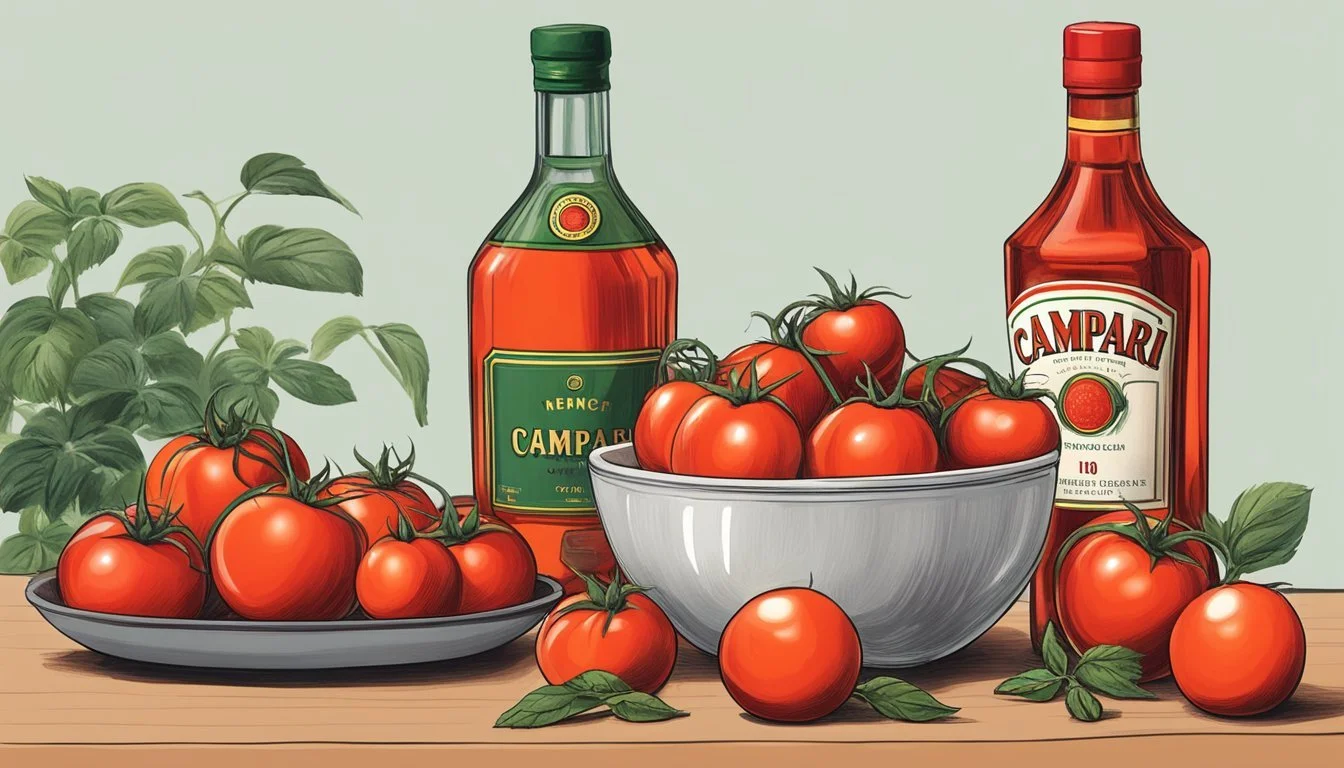Campari Tomatoes Substitutes
Best Alternatives for Recipes
Finding the perfect substitute for Campari tomatoes can elevate your dish without compromising on flavor and texture. Whether due to availability issues or personal preference, knowing the right alternatives is essential for any home cook or chef. Grape tomatoes, cherry tomatoes, plum tomatoes, and Super Sweet 100 can all be excellent substitutes for Campari tomatoes. Each of these varieties offers a unique blend of sweetness and acidity, closely mimicking the taste profile of Campari tomatoes.
In addition to these, Tomaccio tomatoes also stand out as an impressive substitute due to their rich flavor and similar size. These substitutes are not just limited to salads; they can be seamlessly incorporated into sauces, salsas, and even roasted dishes. Exploring these alternatives ensures that your meals maintain their intended taste and quality, regardless of Campari tomato availability.
Understanding Campari Tomatoes
Campari tomatoes are renowned for their unique characteristics and versatility in various culinary applications. These tomatoes offer a delightful balance between sweetness and acidity, making them a popular choice among chefs and home cooks alike.
Characteristics and Flavor Profile
Campari tomatoes, often referred to as "cocktail tomatoes," are larger than cherry tomatoes but smaller than typical field tomatoes. They are known for their bright red color and a firm texture that holds up well in slices. Unlike some tomatoes that can be overly acidic or bland, Campari tomatoes have a balanced flavor, combining sweetness and mild acidity.
Their flavor is often described as full-bodied, with a delightful sweetness that is more pronounced than in many other tomato varieties. Juicy and aromatic, they can enhance the taste of both raw and cooked dishes. This characteristic makes them a versatile ingredient in the kitchen.
Culinary Uses
Campari tomatoes shine in fresh preparations such as salads, where their sweetness and firm texture add a pleasing bite. They are also excellent when sliced for sandwiches and burgers, maintaining their shape and adding a burst of flavor.
In cooking, these tomatoes excel in sauces like marinara or pasta sauce, where their sweetness deepens the overall flavor. Due to their balanced acidity, they also work well in salsas and chutneys.
Their ability to hold shape under cooking means they are ideal for roasting, grilling, or sautéing, making them a versatile ingredient for various culinary techniques.
Campari and Its Role in Cocktails
Campari, a vibrant red Italian aperitif, is renowned for its bitter flavor profile and versatile use in cocktails. Its unique blend of herbs and fruit extracts makes it an essential addition to many classic and contemporary drinks.
Campari as an Essential Cocktail Ingredient
Campari’s distinctive bitter taste, derived from a secret infusion of herbs and fruits, sets it apart in the world of spirits. Its bright red color and complex flavor profile make it a key ingredient in various cocktails.
As an aperitif, it serves to stimulate appetite, making it perfect for pre-dinner drinks. Mixologists often pair it with other ingredients like vermouth, soda water, and gin, crafting balanced and refreshing beverages.
Home bars often feature Campari due to its versatility, allowing enthusiasts to recreate renowned drinks with ease. Its role as a foundational element in numerous recipes highlights its indispensability in the cocktail realm.
Iconic Campari Cocktails
Negroni: A classic cocktail combining Campari, gin, and sweet vermouth. Its equal parts ratio creates a balanced and boldly flavored drink, garnished with an orange twist.
Americano: This cocktail mixes Campari with sweet vermouth and soda water, offering a lighter alternative to the Negroni. Served over ice with a lemon twist, it is a refreshing aperitif.
Campari Spritz: A modern favorite, the Campari Spritz, combines Campari with prosecco and soda water. This sparkling cocktail, garnished with an orange slice, is perfect for summer evenings.
These cocktails underscore Campari’s versatility and enduring appeal in the world of mixed drinks.
Campari Substitutes
When Campari isn't available, several alternatives can provide similar flavors and experiences. These substitutes, both Italian and non-Italian, bring unique qualities that can complement your cocktails and culinary creations.
Similar Italian Bitters
The most similar Italian bitters to Campari include Aperol, Contratto Bitter, and Cappelletti Aperitivo Americano.
Aperol is the closest match, known for its rhubarb and herb infusion, and a bright orange hue.
Contratto Bitter offers a more complex flavor with additional citrus and herbal notes, making it a versatile substitute.
Cappelletti Aperitivo Americano maintains a traditional bittersweet profile and deep red color, ideal for a wide range of mixed drinks.
Cynar and Luxardo Bitter round off this list, with Cynar bringing a unique artichoke flavor and Luxardo being another strong, bittersweet contender.
Non-Italian Alternatives
For non-Italian options, Fernet Branca and several red amaros like Knight Gabriello Rosso Amaro and Aperix Aperativo can serve as substitutes.
Fernet Branca has a bolder, more intense taste, highlighted by its strong herbal component.
Knight Gabriello Rosso Amaro and Aperix Aperativo maintain a balance of bitterness and sweetness, similar to Campari, suitable for cocktails.
These alternatives offer diverse flavors yet achieve a comparable bittersweet profile, essential for recreating classic Campari-based drinks.
Homemade Substitutes
For those who prefer a DIY approach, creating a homemade substitute involves infusing ingredients like vodka, gentian root, orange and lemon peels, angelica root, and wild cherry bark.
Combine these in a jar and leave to infuse for 10-14 days in a cool, dry place. This method allows customization of the flavor profile to closely match Campari.
Some enthusiasts also add wormwood for additional bitterness and complexity, resulting in a personalized homemade bitters experience.
Experimenting with quantities and additional herbs can closely approximate the unique taste of Campari.
Non-Alcoholic Replacements
When seeking non-alcoholic substitutes for Campari tomatoes, options like fruit juice mixes and homemade bittersweet syrups offer excellent replacements, maintaining the flavor profile without the alcohol content.
Fruit Juice Mixes as Substitutes
Pomegranate juice is a common substitute, providing a fruity and complex flavor. Mixed with a dash of bitters, it mimics the bitterness and red hue of Campari. For a sweeter taste, one may use grenadine syrup, but in smaller quantities due to its high sugar content.
Maraschino juice is another alternative. It's less bitter but adds a unique flavor when combined with other fruit juices. These substitutes work well in both beverages and recipes, offering versatility without alcohol.
Creating Bittersweet Syrups
Making a bittersweet syrup at home can be a great option. Start by combining pomegranate juice, a small amount of maraschino juice, and a pinch of bitters. Simmer the mixture until it thickens into a syrup.
For a more complex profile, add a citrus peel. This homemade syrup captures the balance of sweetness and bitterness characteristic of Campari. It's ideal for using in dishes or as a flavorful addition to sparkling water, providing a non-alcoholic yet sophisticated taste.
Pairing Substitutes with Food
When substituting Campari tomatoes, it’s essential to consider the balance of flavors in your dishes and how the substitutes will complement other ingredients. This approach ensures that the flavors maintain harmony whether you're preparing salads, sauces, or cooked meals.
Selecting Substitutes for Cooking
Using grape tomatoes or cherry tomatoes as substitutes maintains a similar sweetness and juiciness that complements various dishes. Plum tomatoes, with their meatier flesh, serve well in sauces and cooked dishes where a thicker texture is beneficial.
For recipes requiring a sweeter profile, the Super Sweet 100 variety is an excellent choice. These tiny, sweet tomatoes are perfect for salads or as a garnish, adding bursts of flavor without overwhelming the dish.
Tomaccio tomatoes bring a unique taste that pairs well with grilled vegetables or meats. Their slight kick of flavor enhances both simple and complex recipes.
Developing Flavors in Dishes
Integrating substitutes for Campari tomatoes can influence the overall flavor profile of your meals. When using grape or cherry tomatoes, adding a touch of balsamic vinegar or a sprinkle of italian herbs can enhance their sweetness and add depth.
For plum tomatoes, incorporating spices like basil, oregano, and garlic helps to elevate their hearty flavor, especially in sauces or slow-cooked dishes. This combination works well with Italian-inspired recipes.
In salads, drizzling a light vinaigrette over Super Sweet 100 tomatoes can highlight their natural sweetness, while a touch of fresh lemon juice brightens the dish. This is ideal for summer salads or light appetizers.
To elevate the Tomaccio tomatoes further, pairing them with maraschino cherries in dishes like gourmet salads or as a side with roasted meats introduces a sophisticated blend of sweet and tangy notes.
By thoughtfully selecting and combining these substitutes, the distinct flavors and textures of Campari tomatoes can be effectively mirrored in various culinary creations.







